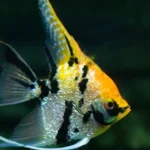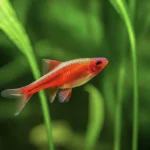Love a clean aquarium, but hate the constant battle against algae? Meet the lawnmower blenny, your quirky and hardworking solution for keeping your tank in tip-top shape! These little fish are not only adorable, but they’re also algae-devouring machines, hence their nickname. This comprehensive guide will teach you everything about keeping these fascinating creatures happy and healthy.
Species Summary
The lawnmower blenny ( Salarias fasciatus), also known as the jeweled blenny or sailfin blenny, is a saltwater fish native to the Pacific and Indian Oceans. They’re a popular choice for aquariums due to their algae-eating prowess and entertaining personalities.
It’s All About the Looks: Understanding Lawnmower Blenny Appearance
Color and Patterns
Lawnmower blennies are masters of camouflage! Their bodies are typically olive or brown, with darker bars and a multitude of white or blue spots. They can even change their coloration slightly to blend in with their surroundings.
Size
These blennies are relatively small fish, reaching a maximum size of about 5-6 inches in length. Their compact size makes them ideal for smaller aquariums.
Lifespan and Growth
Lawnmower blennies have a typical lifespan of 3-5 years in a well-maintained aquarium. They grow relatively quickly, reaching maturity within a year.
Setting Up the Perfect Blenny Habitat
Tank Size
While lawnmower blennies are small, they still need some room to zip around! A minimum of 30 gallons is recommended for a single blenny. If you plan to keep a group, you’ll need a larger tank.
Water Parameters
Lawnmower blennies thrive in water conditions that mimic their natural reef
environment. Here’s the ideal range:
- Temperature: 72-78°F (22-26°C)
- pH: 8.1-8.4
- Salinity: 1.020-1.025
- Ammonia: 0 ppm
- Nitrite: 0 ppm
- Nitrate: <20 ppm
Aquascaping for Your Blenny
Lawnmower blennies adore live rock! It’s their playground, feeding ground, and hiding place all rolled into one. Create plenty of nooks, crannies, and caves for them to explore and feel secure. You can also add corals, but be aware these blennies might nibble on softer corals occasionally.
Blenny Health: Avoiding Illness
Lawnmower blennies are relatively hardy, but like all fish, they’re susceptible to some
common diseases. Keep a close eye out for:
- Ich: White spots on their bodies.
- Fin rot: Damaged or disintegrating fins.
- Bacterial infections: Redness, swelling, or unusual behavior.
Maintaining pristine water quality is the key to preventing most diseases. A healthy
lawnmower blenny is active, alert, and constantly munching!
Blenny Buffet: Feeding Your Algae-Loving Friend
The main attraction of lawnmower blennies is their insatiable appetite for algae. Ideally,
your tank should have a good supply of algae for them to graze on. However, you’ll still
likely need to supplement their diet with:
- Algae wafers or pellets: Look for ones designed for herbivores.
- Nori sheets: Clip a piece to the side of your aquarium for them to nibble on.
- Blanched vegetables: Occasionally offer small amounts of spinach, zucchini, or broccoli.
Blenny Behavior: Get to Know Your Quirky Fish
Lawnmower blennies are full of personality! They spend their days perching on rocks, darting through caves, and constantly grazing on algae. Watching them is like having a tiny, hilarious nature documentary in your own living room.
Territorial or Peaceful?
While generally peaceful towards other fish species, lawnmower blennies can get a bit feisty with their own kind, especially in smaller tanks. It’s usually best to keep just one blenny per aquarium unless you have a very large setup.
Blenny Hideouts
These fish can be a bit shy, especially when they are new to an aquarium. Remember all those caves and nooks you created in their aquascaping? They’ll make use of those as safe havens and places to rest at night. You may think your blenny has disappeared, but chances are, it’s just expertly hiding!

Finding the Right Tank Mates for Your Blenny
Choosing tankmates for your lawnmower blenny requires some consideration. Here’s
What to keep in mind:
- Peaceful: Avoid large, aggressive fish that might view your blenny as a snack. Good tank mates include clownfish, gobies, smaller wrasses, and peaceful tangs.
- Not Too Similar: While they may tolerate other blenny species with significantly different appearances, keeping multiple lawnmowers or close relatives in the same tank is asking for trouble.
- Invertebrates: Use caution with invertebrates like snails or shrimp, as blennies occasionally get curious and may nibble on them.
Conclusion
If you’re looking for a fun, hardy, and unique addition to your saltwater aquarium, a lawnmower blenny might be the perfect choice! They help keep your tank clean, their comical appearance and antics are endlessly entertaining, and they’re relatively easy to care for.
Just remember, they need a well-established tank with plenty of algae and places to hide. If you can provide that, you’ll be rewarded with a fascinating and beneficial little tankmate.
Do lawnmower blennies eat hair algae?
Sometimes! While their primary diet is short turf algae, they may nibble on hair algae, especially if they get hungry. However, don’t rely on them to eradicate a major hair algae outbreak.
Are lawnmower blennies reef safe?
Mostly. They are generally peaceful towards corals, but there’s always a chance they may take an experimental nibble on soft corals. It’s best to supervise them when first introduced to a reef tank.
Can lawnmower blennies jump?
Absolutely! They are known for hopping from rock to rock and can even jump out of the tank if it isn’t covered securely. A tight-fitting lid is a must with these guys.
How many lawnmower blennies should I get?
For most aquariums, stick with just one lawnmower blenny. They can be territorial with their own kind, leading to aggression.
My lawnmower blenny isn’t eating the algae, what should I do?
Make sure there’s enough algae growth available. If your tank is too clean, they won’t have anything to graze on. You’ll need to supplement their diet with algae wafers, nori, and blanched vegetables.


